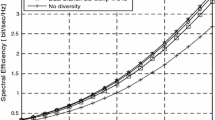Abstract
The analytic methods of average LCR (Level Crossing Rate) and AFD (Average Fading Duration) are applied in the analysis for the SC (Selection Combining) diversity, which works over the correlated Weibull statistics channel. The dual branch SC diversity was used to prove the accuracy of the derived theoretical formula in this paper. We adopt different probability density functions (pdf) and cumulate distribution functions (CDF) to show the Moreover, the numerical results obtained from computer are verified to the published researches.
Similar content being viewed by others
References
1 M.A. Teneda, J. Takada, and K. Araki, “The Problem of the Fading Mobile Selection”, IEICE Trans. on Commun., Vol. E84-B, No 3, pp. 355–358, 2001.
2 J. Proakis, Digital Communications, Mcgraw-Hill, 3rd ed. New York, 1995.
3 T.S. Rappaport, “Wireless Communication Principles & Practice”, Prentice Hall PTR Upper Saddle River. New Jersey, 1996.
4 M. Patzold, Mobile Fading Channels, John Wiley & Sons Ltd. New York, 2002.
5 M.K. Simon and M.-S. Alouini, Digital Communication over Fading Channels, Wiley, 1st ed. New York, 2000.
6 N. Kong, T. Eng, and L.B. Milstein, “A Selection Combining Scheme For Rake Receivers”, 4th IEEE International Conference on Universal Personal Commun., pp. 426–430, 1995.
7 W.C. Jakes, Microwave Mobile Communication. New York, NY: IEEE Press, 1993.
8 C.D. Iskander and P.T. Mathiopoulos, “Analytical Level Crossing Rate and Average Fade Durations for Diversity Techniques in Nakagami Fading Channels”, IEEE Trans. on Commun., Vol. 50, No. 8, pp. 1301–1309, 2002.
9 M. Patzold and F. Laue, “Level-Crossing Rate and Average Duration of Fades of Deterministic Simulation Models for Rice Fading Channels”, IEEE Trans. Veh. Technol., Vol. 48, No. 4, pp. 1121–1129, 1999.
10 F. Adachi, M.T. Feeney, and J.D. Parsons, “Level Crossing Rate and Average Fade Duration for Time Diversity Reception in Rayleigh Fading Conditions”, IEEE Proc., Vol. 135, No. 1, pp. 11–17, 1988.
11 L. Yang and M.S. Alouini, “An Exact Analysis of the Impact of Fading Correlation on the Level Crossing Rate and Average Outage Duration of Selection Combining”, Submitted to IEEE Trans. on Commun., 2002.
12 X. Dong and N.C. Beaulieu, “Level Crossing Rate and Average Fade Duration of Selection Diversity”, IEEE Commun. Lett., Vol. 5, pp. 396–398, 2001.
13 T.T. Tjhung and C.C. Chai, “Fade Statistics in Nakagami-Lognormal Channels”, IEEE Trans. on Commun., Vol. 47, No. 12, pp. 1769–1772, Dec. 1999.
14 N.C. Sagias and G.K. Karagiannidis, “Performance of Dual Selection Diversity in Correlated Weibull Fading Channels”, IEEE Trans. on Commun., Vol. 52, No. 7, pp. 1062–1067, 2004.
15 Joy Iong-Zong Chen, “Evaluation for Average LCR and AFD of Dual MRC and SC Diversity over Correlated Nakagami Environments”, Journal of Wireless Personal Communications, revised, 2004.
16 K. Bury, Statistical Distribution in Engineering. Cambridge, U.K: Cambridge Univ. Press, 1999.
17 I.S. Gradshteyn and I.M. Ryzhik, Table of Integrals, Series, and Products, 5th ed. New York: Academic, 1994.
18 A. Papoulis, Probability, Random Variables, and Stochastic Processes, 3rd ed. New York: Mcgraw-Hill, 2002.
19 J.C. Lu and G.K. Bhattaacharyya, “Some New Constructions of Bivariate Weibull Models”, Ann. Inst. Stat. Math, Vol. 42, No. 3, pp. 543–559, 1990.
20 S. Kotz, N. Balakrishnan, and N.L. Johnson, Continuous Multivariate Distributions. Vol. 1: Model and Applications. New York: Wiley, 2000.
21 S.O. Rice, “Statistical Properties of a Sine Wave Plus Noise”, Bell System Tech. J., Vol. 27, pp. 109–157, 1948.
22 P.J. Crepeau, “Uncoded and Coded Performance of MFSK and DPSK in Nakagami Fading Channels”, IEEE Trans. on Commun., Vol. 40, No. 3, pp. 487–493, 1992.
Author information
Authors and Affiliations
Corresponding author
Rights and permissions
About this article
Cite this article
Chen, J.IZ. Average LCR and AFD for SC Diversity Over Correlated Weibull Fading Channels. Wireless Pers Commun 39, 151–163 (2006). https://doi.org/10.1007/s11277-006-9084-z
Received:
Accepted:
Published:
Issue Date:
DOI: https://doi.org/10.1007/s11277-006-9084-z




